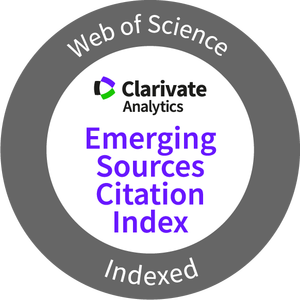Role of training programs approved by the Iraqi Athletics Federation on the performance of Iraqi coaches
Resumen
The purpose of this study was to investigate the role of training programs approved by the Athletics Federation on the performance of coaches in Iraq and also to develop a model for evaluating the performance of athletic coaches. A cross-sectional study was carried out. A total of 60 experts from the Athletics Federation participated in the study. To collect data, a modified questionnaire by Mohammadi (2016) was used. The face and content validity of the questionnaire was confirmed by sports management professors and its reliability was higher than 0.7. In order to analyze the research data, the Statistical Package for the Social Sciences (SPSS version 22) was used, and to perform structural equations and model presentation the AMOS software was used. Based on the results of the exploratory factor analysis, eight factors were identified, which in order of priority included technical skills, management skills, classroom teaching techniques, motivational skills, individual and moral characteristics, sport characteristics and work experience, emotional and human characteristics and social characteristics. Also, the results of the structural equation modeling test showed that all factors were statistically significant (p = 0.001) and the research model had a good fit. Regarding the results of the research, it was concluded that for coaches to perform more successful, technical and management skills should be given more importance than other factors. The role of athletics programs in training coaches is also very important. Therefore, developing the capabilities of coaches is not possible without using a system of monitoring and evaluating performance.
Descargas
Citas
Adams, K. A. (1997). Measurement of Student Athlete Perception of Their Intercollegiate Head Coaches on Conceptual, Human, and Technical Managerial Skills. [Doctoral Thesis, Temple University, Philadelphia].
Barber, H., & Eckrich, J. (1998). Methods and criteria employed in the evaluation of intercollegiate coaches. Journal of Sport Management, 12(4), 301-322. https://doi.org/10.1123/jsm.12.4.301
Bazargan, A. (2002). Educational Evaluation. The Press.
Bradley, M. M., Codispoti, M., Cuthbert, B. N., & Lang, P. J. (2001). Emotion and motivation I: Defensive and appetitive reactions in picture processing. Emotion, 1(3), 276–298. https://doi.org/10.1037/1528-3542.1.3.276
Clutterbuck, D. A., & Spence, G. (2017). Working with goals in coaching. The SAGE handbook of coaching. Sage Publications Ltd.
Dowdell, T. (2010). Characteristics of effective gymnastics coaching. Gymnastics Journal, 2(1), 15-24.
Ebrahimzadeh, M. A., Hosseinimehr S. J., Hamidinia, A., & Jafari, M. (2008) Antioxidant and free radical scavenging activity of Feijoa sallowiana fruits peel and leaves. Pharmacologyonline, 1, 7-14.
Gunaratne, A. K., & Plessis J. A. (2007). Performing management system: A powerful tool to achieve organizational goals. Journal of Global Business and Technology, 3(1), 17-28.
Hamidi, M., & Mehmari, J. (2014). Explaining the exploratory model of selection criteria for national coaches. Sports Management Studies, 24, 58-31.
Honari, H., Moradi, M., Ahmadi, A. H., & Sarreshtehdari, M. (2013). Ranking Those Indicators Involved in Selecting Football National Team Coaches in Iran. Sport Physiology &Management Investigations, 5(2), 33.
Kavussanu, M. (2008). Coaching Efficacy and Coaching Effectiveness: Examining Their Predictors and Comparing Coaches and Athletes Reports. The Sport Psychologist, 22, 383-404.
Khosro, N., Mohammad, K., Nasrollah, S., & Anooshirvan, K. (2009). Analysis and Modeling of Evaluation of Coaches of National Handball Teams. Journal of Motion Sport Management, 1(1), 119-140.
Larson, E. W., & Gobeli, D. H. (1990). Towards Effective Infrastructure Development in Nigeria: Theoretical Considerations from a Project Management Perspective. Engineering Management Journal, 2, 31-36.
Memary, J., Hamidi, M., & Tahere, S. (2013). Study the training program, evaluation and promotion of sports coaches in selected countries and provide suggestions. Applied Research in Sports Management, 2(2), 112-99.
Mir, F., Tikmani, S. S., Shakoor, S., Warraich, H. J., Sultana, S., Ali, S. A., & Zaidi, A. K. (2011). Incidence and etiology of omphalitis in Pakistan: a community-based cohort study. The Journal of Infection in Developing Countries, 5(12), 828-833. https://doi.org/10.3855/jidc.1229
Mohammad, A. A. (2003). Current situation in the development of talent handicaps in the men's handball field. Institute of Physical Education and Sport.
Monazami, R. (2009). Nuclear magnetic resonance in microfluidic environments using inductively coupled radiofrequency resonators. Journal of Magnetic Resonance, 198(1), 132-136.
Nasser, M. (2009). Analytical Research in the Evaluation of Public Employees and Managers of Public Administration Training Centers. Journal of Public Administration, 6, 10-21.
Nejad, R., Rezaei, R., Khosravi, M., & Mina, Azar-Molaei. (2013). Comparison of Performance Indicators of Club Coaches from the Perspectives of Athletes, Trainers and Experts. Journal of Sport Management, 17, 191-214.
Rainer, M. (2004). Successful Instructor. Astan Quds Razavi.
Reza, R. (2002). Prioritize some of the coaching features from the perspective of national level coaches and wrestlers. Movement Journal, 11, 119-131.
Roger, J., & Richard, P. (2001). Sports Management Guide. National Olympic Committee Publications.
Rouhani, M., Talibpour, M., & Nejad, R. (2013). Factor Analysis of Performance Evaluation Indicators of Iranian Professional Football Coaches. Applied Research in Sports Management, 2(2), 48-35.
Shafiee, M., Goodarzi, M., Hamidi, M., Mehrzad, Yadalahi., & Jahangir. (2007). Designing and explaining the selection criteria for coaches of national swimming, diving and water polo teams from the perspective of coaches in this field. Movement, 32(32).
Szymanski, S. (2000). A Market Test for Discrimination in the English Professional Soccer Leagues. Journal of Political Economy, 108(3), 590-603.
Taghavi, M., & Mohammadi, H. (2006). The Effect of Human Capital on Economic Growth: Case of Iran. Economics Research, 6(22), 15-43.
Talebpour, M., Mohsen, L., Meysam, R., & Vahid, R. (2014). Designing a prediction model of the attitudinal and behavioral outcomes among professional Iranian soccer coaches. Applied Research in Sports Management, 2(6), 78-92.
Zadegan, A., Mohammad, M., & Jafar, T. (2001). Educational Needs Assessment in Organizations. Tehran: Publishing Company, First Printing.
Las obras que se publican en esta revista están sujetas a los siguientes términos:
1. El Servicio de Publicaciones de la Universidad de Murcia (la editorial) conserva los derechos patrimoniales (copyright) de las obras publicadas, y favorece y permite la reutilización de las mismas bajo la licencia de uso indicada en el punto 2.
© Servicio de Publicaciones, Universidad de Murcia, 2013
2. Las obras se publican en la edición electrónica de la revista bajo una licencia Creative Commons Reconocimiento-NoComercial-SinObraDerivada 3.0 España (texto legal). Se pueden copiar, usar, difundir, transmitir y exponer públicamente, siempre que: i) se cite la autoría y la fuente original de su publicación (revista, editorial y URL de la obra); ii) no se usen para fines comerciales; iii) se mencione la existencia y especificaciones de esta licencia de uso.
3. Condiciones de auto-archivo. Se permite y se anima a los autores a difundir electrónicamente las versiones pre-print (versión antes de ser evaluada) y/o post-print (versión evaluada y aceptada para su publicación) de sus obras antes de su publicación, ya que favorece su circulación y difusión más temprana y con ello un posible aumento en su citación y alcance entre la comunidad académica.




















